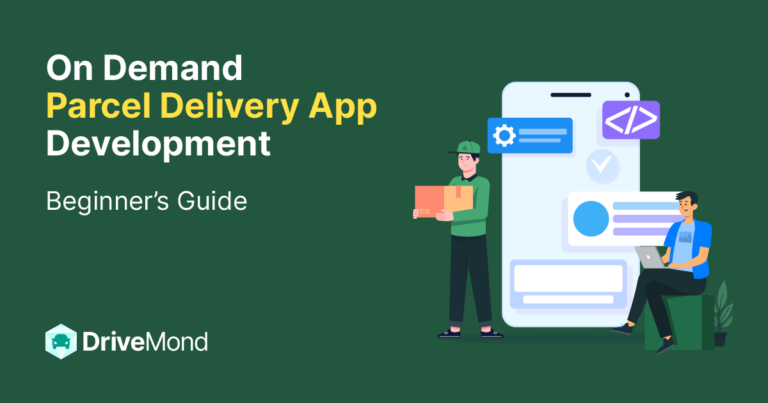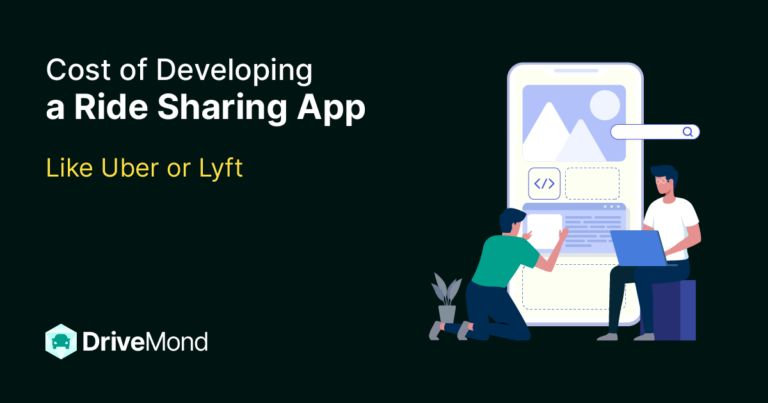One day, I was sitting in a cafe, lost in my thoughts, sipping my coffee, and working on a very recent project for a client. Outside, the roads were pulsing with energy. Looking out the window, I noticed endless delivery trucks crisscrossing the streets. Each one represents a different parcel delivery company with its own work process.
But I quickly realized I was also developing a parcel delivery system for my client. Then I thought, why not share the process with you as well? That’s why I’ve written this parcel delivery app development guide for my fellow coders out there.
This is a beginner-friendly guide I’ve designed to help developers like you who are looking for a simple guideline to build a parcel delivery app from scratch.
Now that we’ve set the stage, let’s begin!
What is A Parcel Delivery App?
A parcel delivery app is a digital platform that is used to send, track, and receive parcels from one person to another.
A parcel delivery app typically has 3 types of users- sender, receiver, and deliveryman. But there’s also an admin who manages the entire process from the backend.

Flowchart: Parcel Delivery App Work Process
Why Are On Demand Parcel Delivery Apps So Popular?
The on demand parcel delivery apps are so popular because they offer convenience, efficiency, and flexibility to both senders and recipients. Using the app, users can request and track parcel deliveries in real-time.
According to source, the worldwide parcel delivery industry is predicted to increase by nearly $654.84 billion by 2030.
Parcel delivery apps have made people’s lives easier with door-to-door parcel delivery services that meet customers’ demands. It also offers must-have features like instant notifications, easy payment options, on-time customer support, parcel tracking systems, etc. With quick expansion opportunities, you can get more customers on board and build a scalable on demand parcel delivery business.
Also Read: How to Develop a Ride Sharing App?
Step-by-step Instructions for Parcel Delivery App Development
Here’s the proven step-by-step guide I followed for parcel delivery app development. And I know you’ll find it useful as well 👇
Step 1: Market Research
Do your market research and note down users’ needs and preferences, such as better delivery efficiency, minimizing users’ checkout journey, and so on. You can determine the goals and objectives of your parcel delivery app.
Keep in mind:
- Who your audiences are
- What your goals and objectives are
- What is your business model, etc.
Step 2: List Down the Features
Once you know what you want to do with your parcel delivery app, you better list the features you want to introduce.
Pro tip: while listing those features, note down which APIs or technologies you will need to develop them, okay? This will save a lot of time.
Step 3: Get Those Technologies & Tech Teams Ready
In this phase, you have to define the technologies or ‘Tech Stack’ you’re going to use for the ‘3D’s- Design, Development, and Deployment.’ Below, I’ve divided the technology stacks according to how I work 👇
| Stage | Technology Stack | |
| Design | Wireframing & Prototyping | Sketch, Adobe XD, or Figma |
Development | Frontend | React Native for cross-platform mobile app development |
| Backend | Node.js with Express.js for server-side logic | |
| Database | MongoDB or PostgreSQL for data storage | |
| API Integration | REST APIs or GraphQL for communication | |
| Maps Integration | Google Maps API or Mapbox API for location tracking | |
| Push Notifications | Firebase Cloud Messaging (FCM) or OneSignal for real-time notifications | |
| Payment Gateways | Stripe, Paypal, SSLCommerz, etc. | |
Deployment | Hosting | Amazon Web Services (AWS) or Google Cloud Platform (GCP) for cloud hosting |
| Continuous Integration/Continuous Deployment (CI/CD) | GitHub Actions or Jenkins for automated deployment | |
| Monitoring | Sentry or New Relic for error tracking and monitoring | |
| Analytics | Google Analytics or Mixpanel for app analytics | |
Table: Tech Stack for Parcel Delivery App Development
In my opinion, these are the best technology stacks for developing a parcel delivery app.
If you’re a software developer like me, you can get your parcel delivery app development project started according to your client’s requirements. Please note that working in a team of other developers is better than working independently. That’s because you might not be able to design, develop, and deploy on your own, right? Well, there are ready-made solutions available in the market to reduce the hassle of building a parcel delivery app from scratch. keep
If your client gives you the UI and ensures he’ll take care of the Deployment, things might be easier for you. Or else, you might want to build your own small team on a contractual basis to build a parcel delivery app from scratch.
Step 4: Design & Develop
Now that you have selected your technology stack and have your own tech team, it’s time to design and develop your app. A dedicated project manager will help you handle all the tasks according to your timeline. So, hiring a full-time project manager for your parcel delivery app development project is better.
Step 5: Test The App and Ensure Perfect User Experience
There’s a famous saying that ‘if you don’t like testing your product, your customers won’t like to test it either’- and that’s so true. Make sure to test your product during every phase of development, no matter how small it is. Ask a SQA engineer friend to help you with the testing.
If you’re a business owner or a startup, make sure you have an expert SQA engineer who’ll do the essential testing and bug fixing for your parcel delivery app development solution.
In either case, the goal is one- make your on demand delivery platform an industry-standard product.
Step 6: Launch & Post-Launch
It’s time to release your parcel delivery app online for real users to use. In this phase, you can do marketing relevant to your target audience if you’re a business. If you’re a developer, you must hand over the project to your client by the release date.
But does it mean that our work is done here?
No.
Now comes the post-launch tasks.
To keep your parcel delivery app up-to-date and in-trend, you must introduce new features, monitor app performance (including user engagement, app crashes, and server uptime) to ensure optimal functionality, release software updates with updated security patches, polish existing UI and feature, and the list goes on.
Also Know: DriveMond's Which Package is Right for You?
Ready-built Parcel Delivery App
DriveMond is a ready-built ride sharing app that includes a parcel delivery app solution. This means you get the best of both worlds from one single solution. And guess what- you have to spend “zero” time, resources, and cost on developing a parcel delivery app from scratch! You can instantly deliver an MVP-standard product to your clients.
For developers like you and me, DriveMond comes with flexible pricing packages for serving clients worldwide 👇

If you’re a businessman, DriveMond has to offer you the best package ever! Check their pricing for businessmen below 👇

You need to find the top talents from the industry to develop your parcel delivery app. You can look for freelance software developers and tech experts to handle your projects or hire an experienced software development agency to make it work 2x faster and more efficiently.
Wrapping Up
I hope this blog has given you a clear guide on how to develop a parcel delivery app. As a fellow coder, I want you to win your customers’ hearts at any steak!
FAQs
How can I ensure ongoing maintenance and support for my parcel delivery app?
Ongoing maintenance involves regular updates, bug fixes, performance optimization, and providing customer support channels for users. Consider implementing analytics tools to monitor app performance and gather user feedback for continuous improvement.
What are some best practices for testing and deploying a parcel delivery app?
Best practices include conducting thorough testing at each stage of development, including unit testing, integration testing, and user acceptance testing. Utilizing continuous integration/deployment (CI/CD) pipelines for automated testing and deployment processes.
What programming languages and frameworks are commonly used for parcel delivery app development?
Commonly used languages and frameworks include React Native for cross-platform mobile app development, Node.js with Express.js for backend development, and MongoDB or PostgreSQL for database management.









